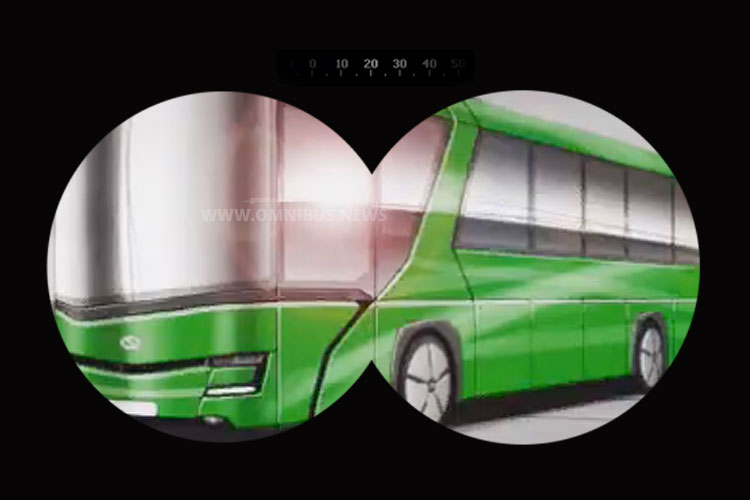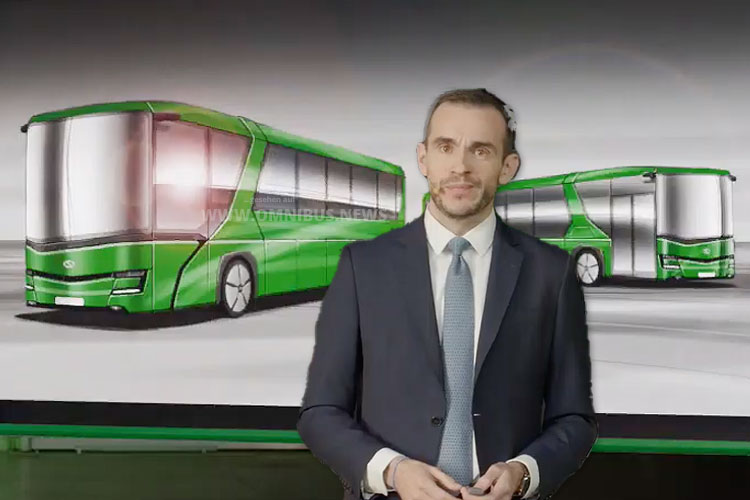
Solaris kündigt für 2026 einen elektrisch angetriebenen Überlandbus an. Foto: Screenshot Solaris; Montage: omnibus.news

Solaris-CEO Javier Iriarte kündigt für eine BEV-Variante an, um auch im Segment der Überlandbusse der Rolle des Marktführers bei Zero-Emissionen-Antrieben in Europa gerecht zu werden. Foto: Screenshot Solaris; Montage: omnibus.news
Auf der Jahrespressekonferenz von Solaris gab es nicht nur einen Rückblick auf die Zahlen des abgelaufenen Geschäftsjahres, sondern auch Ausblicke aus das, was die polnische Marke unter dem Dach der CAF-Gruppe für die nächste Jahre plant. Spannend, im wahrsten Sinne!
Dazu heute im Anschluss an die Pressekonferenz auch die erste News: Das Segment der Überlandbusse ist in Europa eine feste Größe. Solaris stellte 2009 die Baureihe InterUrbino vor, die seit 2010 bis heute im polnischen Bolechowo gebaut wird – mit klassischem Verbrenner.
Nun steht eine BEV-Variante an, um auch im Segment der Überlandbusse der Rolle des Marktführers bei Zero-Emissionen-Antrieben in Europa gerecht zu werden. Von den 1.456 produzierten Linienbussen der Marke Solaris, die 2023 hergestellt wurden, hatten 82 Prozent einen alternativen Antrieb, wie Javier Iriarte im Rahmen der Jahrespressekonferenz erklärte.
Rechnet man BEV- und FCEV-Antriebe bei den Neuzulassungen des Jahres 2023 in Europa (EU27, NO und CH) zusammen, dann kommt Solaris europaweit mit 15,2 Prozent Marktanteil auf den 1. Platz. Der 2. Platz geht an die chinesische Marke BYD, an dritter Stelle auf dem Siegertreppchen der neuzugelassenen BEV- und FCEV-Busse steht Mercedes-Benz.
Der wachsenden Konkurrenz aus China und der durchaus aggressiven Preispolitik werde man bei Solaris mit Qualität und Service begegnen, so Iriarte am Ende der Jahrespressekonferenz auf Nachfrage von omnibus.news. Und mit einem kompletten Portfolio unterschiedlicher Gefäßgrößen und Antriebe, wie Javier Iriarte, der die Geschicke von Solaris seit Januar 2023 verantwortet, betonte. Und dazu gehöre auch ein elektrisch angetriebener Überlandbus.
Im Rahmen der Jahrespressekonferenz gab einen ersten Ausblick auf die neue Baureihe. Optisch eine Weiterentwicklung der InterUrbino-Familie, gespickt mit dezenten Erinnerungen an die Vacanza-Omnibusse. das passt nicht nur zum Firmenimage, sondern auch sehr gut ins Portfolio. Weitere Details zur technischen Ausstattung würde man im nächsten Jahr kommunizieren.
Heute ließ sich Javier Iriarte auf Nachfrage von omnibus.news nur wenige Fakten entlocken: „Wir entwickeln derzeit eine neue Plattform, um einen Markt von rund 8.000 Bussen pro Jahr mit unserem Produkt bedienen zu können.“, so Iriarte. Die neue Intercity-Plattform werde es in drei verschiedenen Längen: 10,9, 12,2 und 13 Meter geben.
Aktuell sei man aber schon mit ersten Kunden im Gespräch, um nicht nur erste Aufträge, sondern auch die Bedürfnisse im Detail in den unterschiedlichen Einsatzgebieten Europas auszuloten. Ab 2026 sei der elektrisch angetriebene Überlandbus dann erhältlich. (Solaris/omnibus.news/PM/Sr)
Fehler im Beitrag gefunden? Jetzt melden!

Solaris announces an electrically powered intercity bus for 2026. Photo: Screenshot Solaris; Montage: omnibus.news

Solaris CEO Javier Iriarte announces a BEV variant to fulfill the role of market leader in zero-emission drives in Europe in the intercity bus segment. Photo: Screenshot Solaris; Montage: omnibus.news
At the Solaris annual press conference, there was not only a review of the figures for the past financial year, but also an outlook on what the Polish brand is planning for the coming years under the umbrella of the CAF Group. Exciting, in the truest sense of the word!
Today, following the press conference, the first news: the intercity bus segment is firmly established in Europe. Solaris presented the InterUrbino series in 2009, which has been built in Bolechowo, Poland, since 2010 – with a classic combustion engine.
Now a BEV version is on the cards to do justice to the role of market leader in zero-emission drives in Europe in the intercity bus segment too. Of the 1,456 Solaris buses produced in 2023, 82% had an alternative drive system, as Javier Iriarte explained at the annual press conference.
If BEV and FCEV drives are added together for new registrations in Europe (EU27, NO and CH) in 2023, Solaris comes in first place across Europe with a 15.2 percent market share. Second place goes to the Chinese brand BYD, with Mercedes-Benz in third place on the podium for newly registered BEV and FCEV buses.
At the end of the annual press conference, when asked by omnibus.news, Iriarte said that Solaris would counter the growing competition from China and the aggressive pricing policy with quality and service. And with a complete portfolio of different vehicle sizes and drive systems, as Javier Iriarte, who has been in charge of Solaris since January 2023, emphasized. And this also includes an electrically powered intercity bus.
At the annual press conference, he gave an initial preview of the new series. Visually, it is a further development of the InterUrbino family, peppered with subtle reminders of the Vacanza buses, which not only fits the company image, but also fits very well into the portfolio. Further details on the technical equipment will be communicated next year.
Today, Javier Iriarte was only able to elicit a few facts when asked by omnibus.news: „We are currently developing a new platform in order to be able to serve a market of around 8,000 buses per year with our product,“ said Iriarte. The new Intercity platform will be available in three different lengths: 10.9, 12.2 and 13 meters.
However, the company is already in talks with its first customers in order to sound out not only initial orders, but also the detailed requirements in the various areas of operation in Europe. The electrically powered intercity bus will then be available from 2026. (Solaris/omnibus.news/PM/Sr)
